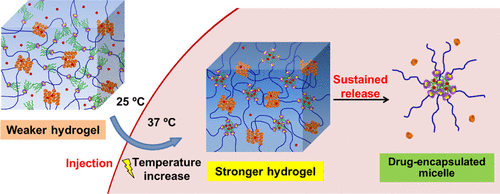当前位置:
X-MOL 学术
›
Biomacromolecules
›
论文详情
Our official English website, www.x-mol.net, welcomes your
feedback! (Note: you will need to create a separate account there.)
Thermoresponsive Hydrogel Induced by Dual Supramolecular Assemblies and Its Controlled Release Property for Enhanced Anticancer Drug Delivery.
Biomacromolecules ( IF 5.5 ) Pub Date : 2020-03-11 , DOI: 10.1021/acs.biomac.0c00077 Xia Song 1 , Zhongxing Zhang 2 , Jingling Zhu 1 , Yuting Wen 1 , Feng Zhao 1 , Lijie Lei 3 , Nhan Phan-Thien 3 , Boo Cheong Khoo 3 , Jun Li 1
Biomacromolecules ( IF 5.5 ) Pub Date : 2020-03-11 , DOI: 10.1021/acs.biomac.0c00077 Xia Song 1 , Zhongxing Zhang 2 , Jingling Zhu 1 , Yuting Wen 1 , Feng Zhao 1 , Lijie Lei 3 , Nhan Phan-Thien 3 , Boo Cheong Khoo 3 , Jun Li 1
Affiliation

|
Supramolecular hydrogels based on inclusion complexation between cyclodextrins (CDs) and polymers have attracted much interest because of their potential for biomedical applications. It is also attractive to incorporate stimuli-responsive properties into the system to create “smart” hydrogels. Herein, a poly(N-isopropylacrylamide) (PNIPAAm) star polymer with a β-CD core and an adamantyl-terminated poly(ethylene glycol) (Ad-PEG) polymer were synthesized. They self-assembled into a thermoresponsive pseudo-block copolymer through host–guest complexation and formed supramolecular micelles with the change in environment temperature. Subsequently, an injectable polypseudorotaxane-based supramolecular hydrogel was formed between α-CD and the PEG chains of the pseudo-block copolymer. The hydrogel had a unique network structure involving two types of supramolecular self-assemblies between cyclodextrins and polymers, that is, the host–guest complexation between β-CD units and adamantyl groups and the polypseudorotaxane formation between α-CD and PEG chains. We hypothesize that the dual supramolecular hydrogel formed at room temperature may be enhanced by increasing the temperature over the lower critical solution temperature of PNIPAAm because of the hydrophobic interactions of PNIPAAm segments. Furthermore, if the hydrogel is applied for sustained delivery of hydrophobic drugs, the copolymer dissolved from the hydrogel could micellize and continue to serve as micellar drug carriers with the drug encapsulated in the hydrophobic core. Rheological tests revealed that the hydrophobic interactions of the PNIPAAm segments could significantly enhance the strength of the hydrogel when the temperature increased from 25 to 37 °C. As compared to hydrogels formed by α-CD and PEG alone, the sustained release property of this thermoresponsive hydrogel for an anticancer drug, doxorubicin (DOX), improved at 37 °C. The hydrogel dissolved slowly and released the pseudo-block copolymer in the form of micelles that continued to serve as drug carriers with DOX encapsulated in the hydrophobic core, achieving a better cellular uptake and anticancer effect than free DOX controls, even in multidrug-resistant cancer cells. According to these findings, the dual supramolecular hydrogel developed in this work with remarkable thermoresponsive properties might have potential for sustained anticancer drug delivery with enhanced therapeutic effect in multidrug-resistant cancer cells.
中文翻译:

双超分子组装诱导的热响应水凝胶及其控释特性,增强了抗癌药物的传递能力。
基于环糊精(CD)和聚合物之间的包合络合的超分子水凝胶,由于其在生物医学领域的潜力而备受关注。将刺激响应特性整合到系统中以创建“智能”水凝胶也很有吸引力。在此,poly(N合成了具有β-CD核的β-异丙基丙烯酰胺(PNIPAAm)星型聚合物和金刚烷基封端的聚乙二醇(Ad-PEG)聚合物。它们通过主体-客体的络合作用自组装成热响应性假嵌段共聚物,并随着环境温度的变化而形成超分子胶束。随后,在α-CD和拟嵌段共聚物的PEG链之间形成了可注射的基于聚伪轮烷的超分子水凝胶。水凝胶具有独特的网络结构,涉及环糊精和聚合物之间的两种超分子自组装,即β-CD单元和金刚烷基之间的主体-客体络合以及α-CD和PEG链之间的聚伪轮烷形成。我们假设在室温下形成的双超分子水凝胶可通过在PNIPAAm的较低临界溶液温度上升高温度来增强,因为PNIPAAm片段之间存在疏水相互作用。此外,如果将水凝胶用于疏水性药物的持续递送,则从水凝胶中溶解的共聚物可能会胶束化并继续充当胶束药物载体,而药物则被包裹在疏水核中。流变测试表明,当温度从25°C升高到37°C时,PNIPAAm片段的疏水相互作用可以显着增强水凝胶的强度。与仅由α-CD和PEG形成的水凝胶相比,该热响应性水凝胶对于抗癌药阿霉素(DOX)的缓释性能在37°C时有所改善。水凝胶缓慢溶解并以胶束形式释放出伪嵌段共聚物,该胶束继续充当药物载体,将DOX包裹在疏水核中,即使在多药耐药的癌症中,也比游离的DOX对照具有更好的细胞摄取和抗癌作用细胞。根据这些发现,在这项工作中开发的具有超强热响应特性的双重超分子水凝胶可能具有持续的抗癌药物递送潜力,并且在多药耐药性癌细胞中具有增强的治疗效果。即使在具有多重耐药性的癌细胞中。根据这些发现,在这项工作中开发的具有超强热响应特性的双重超分子水凝胶可能具有持续的抗癌药物递送潜力,并且在多药耐药性癌细胞中具有增强的治疗效果。即使在具有多重耐药性的癌细胞中。根据这些发现,在这项工作中开发的具有超强热响应特性的双重超分子水凝胶可能具有持续的抗癌药物递送潜力,并且在多药耐药性癌细胞中具有增强的治疗效果。
更新日期:2020-04-23
中文翻译:

双超分子组装诱导的热响应水凝胶及其控释特性,增强了抗癌药物的传递能力。
基于环糊精(CD)和聚合物之间的包合络合的超分子水凝胶,由于其在生物医学领域的潜力而备受关注。将刺激响应特性整合到系统中以创建“智能”水凝胶也很有吸引力。在此,poly(N合成了具有β-CD核的β-异丙基丙烯酰胺(PNIPAAm)星型聚合物和金刚烷基封端的聚乙二醇(Ad-PEG)聚合物。它们通过主体-客体的络合作用自组装成热响应性假嵌段共聚物,并随着环境温度的变化而形成超分子胶束。随后,在α-CD和拟嵌段共聚物的PEG链之间形成了可注射的基于聚伪轮烷的超分子水凝胶。水凝胶具有独特的网络结构,涉及环糊精和聚合物之间的两种超分子自组装,即β-CD单元和金刚烷基之间的主体-客体络合以及α-CD和PEG链之间的聚伪轮烷形成。我们假设在室温下形成的双超分子水凝胶可通过在PNIPAAm的较低临界溶液温度上升高温度来增强,因为PNIPAAm片段之间存在疏水相互作用。此外,如果将水凝胶用于疏水性药物的持续递送,则从水凝胶中溶解的共聚物可能会胶束化并继续充当胶束药物载体,而药物则被包裹在疏水核中。流变测试表明,当温度从25°C升高到37°C时,PNIPAAm片段的疏水相互作用可以显着增强水凝胶的强度。与仅由α-CD和PEG形成的水凝胶相比,该热响应性水凝胶对于抗癌药阿霉素(DOX)的缓释性能在37°C时有所改善。水凝胶缓慢溶解并以胶束形式释放出伪嵌段共聚物,该胶束继续充当药物载体,将DOX包裹在疏水核中,即使在多药耐药的癌症中,也比游离的DOX对照具有更好的细胞摄取和抗癌作用细胞。根据这些发现,在这项工作中开发的具有超强热响应特性的双重超分子水凝胶可能具有持续的抗癌药物递送潜力,并且在多药耐药性癌细胞中具有增强的治疗效果。即使在具有多重耐药性的癌细胞中。根据这些发现,在这项工作中开发的具有超强热响应特性的双重超分子水凝胶可能具有持续的抗癌药物递送潜力,并且在多药耐药性癌细胞中具有增强的治疗效果。即使在具有多重耐药性的癌细胞中。根据这些发现,在这项工作中开发的具有超强热响应特性的双重超分子水凝胶可能具有持续的抗癌药物递送潜力,并且在多药耐药性癌细胞中具有增强的治疗效果。











































 京公网安备 11010802027423号
京公网安备 11010802027423号